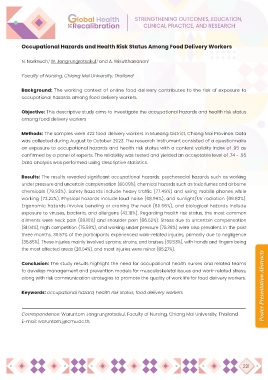Page 223 - GHR_NursingCMU2024_Final.indd
P. 223
Occupational Hazards and Health Risk Status Among Food Delivery Workers
1
1
N. Narknuch, W. Jongrungrotsakul, and A. Wisutthananon 1
1 Faculty of Nursing, Chiang Mai University, Thailand
Background: The working context of online food delivery contributes to the risk of exposure to
occupational hazards among food delivery workers.
Objective: This descriptive study aims to investigate the occupational hazards and health risk status
among food delivery workers
Methods: The samples were 422 food delivery workers in Mueang District, Chiang Mai Province. Data
was collected during August to October 2023. The research instrument consisted of a questionnaire
on exposure to occupational hazards and health risk status with a content validity index of .95 as
confirmed by a panel of experts. The reliability was tested and yielded an acceptable level of .74 - .95
Data analysis was performed using descriptive statistics.
Results: The results revealed significant occupational hazards: psychosocial hazards such as working
under pressure and uncertain compensation (80.09%), chemical hazards such as toxic fumes and airborne
chemicals (79.93%). Safety hazards include heavy traffic (77.49%) and using mobile phones while
working (73.22%). Physical hazards include loud noise (68.96%), and sunlight/UV radiation (66.82%).
Ergonomic hazards involve bending or craning the neck (60.66%), and biological hazards include
exposure to viruses, bacteria, and allergens (42.18%). Regarding health risk status, the most common
ailments were neck pain (89.10%) and shoulder pain (86.02%). Stress due to uncertain compensation
(81.04%), high competition (75.59%), and working under pressure (75.36%) were also prevalent. In the past
three months, 30.57% of the participants experienced work-related injuries, primarily due to negligence
(35.85%). These injuries mainly involved sprains, strains, and bruises (39.53%), with hands and fingers being
the most affected areas (26.04%), and most injuries were minor (85.27%).
Poster Presentation Abstracts
Conclusion: The study results highlight the need for occupational health nurses and related teams
to develop management and prevention models for musculoskeletal issues and work-related stress,
along with risk communication strategies to promote the quality of work life for food delivery workers.
Keywords: occupational hazard, health risk status, food delivery workers
_____________________________________________________________________________________________________
Correspondence: Waruntorn Jongrungrotsakul, Faculty of Nursing, Chiang Mai University, Thailand
E-mail: waruntorn.j@cmu.ac.th
221

